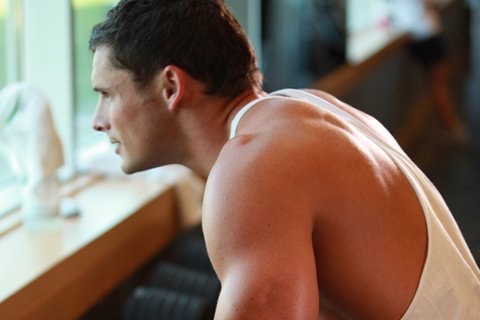In this article I will discuss lactic acid: how it is formed and how it plays a role in delayed onset muscle soreness (DOMS). I will explain what DOMS is, why it happens and what the research shows on how to help ease the pain.
For me, no matter how long I have been exercising; my legs always kill me two days after squats. Part of the reason is, as much as I love to workout, I hate squat days. There are those blessed few who just love crawling out of the squat rack and throwing up in the trash can before the next set (and that's if you do it right).
As much as I hate to admit this, if I can find a reason to "miss" that workout I will. It isn't that I have huge legs and don't think that I need to. It just isn't fun for me. I get no "joy in mudville" when I know it is leg day.
I tend to always find a way to make it into a leg press day instead. I can push a lot more weight that way and feel better. I just haven't gotten anymore size in my legs by doing them. I know I have to just suck it up and squat before I will get any larger.
I am working each body part twice a week, and I rotate my workouts, but only hit squats one time during the week so if I miss a squat workout it might be two weeks without a squat day.
I can always find new muscles in my legs that haven't been used and will get recruited for that next squat routine; hence soreness over the next few days. It makes it so much better when my daughter decides that just then is the best time to run and dive onto my lap when I am sitting on the couch.
I think that she tracks my workouts better than I do and has it down to a science. She either loves me a lot or she is sadistic and really loves to see me in pain.
What Is Doms?
Delayed onset muscle soreness (DOMS) is very familiar to most of us who have been working out for any length of time. Usually it only really happens when we take an extended break from our workout routine. It also happens when we start using a new piece of exercise equipment.
Any "new" thing that challenges our bodies is a good thing but we can, and usually pay for it. We have all experienced our days of soreness but what causes it and what can I do to speed up my recovery?
DOMS describes a phenomenon of muscle pain and soreness that is felt 12-48 hours following exercise, particularly at the beginning of a new exercise program, after a change in sports activities, or after a dramatic increase in the duration or intensity of exercise and subsides over the next few days.

Symptoms can range anywhere from tenderness in the muscle to severe debilitating pain. The soreness is a normal response to unusual exertion and is part of an adaptation process within the body but how does this process occur?
Your body breaks down carbohydrates to produce ATP (Adenosine Triphosphate) via the Glycolytic System. (ATP is the principle energy compound in most cells and the energy is stored within the phosphate bonds.) There are two other systems that provide energy to the system (Phosphagen and Oxidative).
The Phosphagen system produces ATP mainly for high-intensity activities like weight-training and sprinting. It kicks in at the beginning of the activity, usually between 0-6 seconds up to 20-30 seconds.
The Oxidative system is only one that is aerobic and its primary function is to provide ATP for low-intensity activities such as cycling, long distance running and swimming for longer than 3 minutes. This system doesn't just use carbohydrates for fuel. It also uses fats and proteins as well.
The Oxidative system doesn't typically use proteins as a fuel source very much because it doesn't want to break down muscle tissue. This is also the system for the dreaded Krebs Cycle which we have all memorized and forgotten a hundred times (also known as the Citric Acid Cycle and/or the TCA cycle).
For now, I am only going to address the Glycolytic system and its production of Lactic acid.
Lactic Acids Role In Doms
The primary function of the Glycolytic System is to break those carbohydrates down and produce ATP. The energy that it provides is primarily used for moderate to high intensity activities (30 sec up to 3 min).
It does this by either the Fast or Slow method and the Fast Glycolysis is where the Amino Acid Pyruvate is converted to lactic acid. (Note: Lactic Acid is different than Lactate. Lactate is not believed to be fatigue-producing. It is converted from lactic acid and is the indicator of lactic acid production and clearance only because it is the only one that stays in the blood long enough to be checked.)
The lactic acid produced during fast glycolysis creates a negative feedback (interferes) with the calcium release from the Sarcoplasmic Reticulum. (I am presuming a lot with just hitting the high parts of the topic. I want to keep the information as "vanilla" as possible instead of going into great depth on each topic.)
Lactic acid interferes with actomysosin formation (the complex when the actin and myosin bond) and Glycolytic enzyme activity which results in fatigue. That is a lot of information to just tell you that the carbohydrates that your body uses for fuel results in lactic acid which causes you to get sore.
Through training, your body learns to better utilize this system, and/or you get use to the lactic acid build up and you stop being sore after doing the routine for some time.
Treatment Of DOMS
There have been many different treatment strategies to help reduce the intensity of DOMS and to return the athlete to training as fast as possible. Non-steroidal anti-inflammatory drugs (NSAIDS) such as aspirin, ibuprofen and naproxen, have demonstrated dose-dependent effects but can be influenced by when the dose was given.
I am not against all NSAIDS for there are times when the patient might need them on a temporary basis to relieve the symptoms, but I would suggest only using these when other methods have failed. Many problems can occur with the over medication of these drugs that far outweigh their usage. The key word in the use of NSAIDS is temporary.
Massage has also shown some varying results that can be attributed to the time and type of massage technique used. I love the benefits of massage and tell my patients that weekly massage treatments will do a lot of good for their overall health.
In a study published in the Journal of Athletic Training in 2003, ten healthy subjects (5 men, 5 women) with no history of upper arm injury and no experience in resistance training were asked to perform 10 sets of 6 maximal isokinetic eccentric movements of the elbow flexors with both arms.
One arm received 10 minutes of massage 3 hours after the exercise; the other arm received no treatment. They concluded that massage was effective in alleviating DOMS by approximately 30% and reducing swelling, but it had no effects on muscle function.
According to a study published by the School of Community Health and Sports Studies: Cryotherapy (ice packs), stretching, homeopathy, ultrasound and electrical current modalities (muscle stimulation) all have demonstrated no effect on the alleviation of muscle or other DOMS related symptoms.
Exercise is the most effective means of relieving pain during DOMS, but the analgesic effect is temporary. If you have to train on a daily basis, then you should reduce the duration and intensity of exercise for 1-2 days following the exercise that caused the DOMS. You can also train less effected body parts to allow time for the body to recover.
Another key is to train a hard day/light day after you start a new program or routine. Rest is often overlooked in the training regime and you should plan for it. I believe that we usually over train and never give our bodies the required "rest" that it needs to rebuild and repair itself. I know that the "burn" feels good after a workout but it isn't the best thing for you.
Your body is designed to adapt to whatever stress is imposed upon it so if you want to grow, or get in better shape, you have to make changes periodically in your routine to stop from hitting a plateau and getting bored. Any significant change in your workout can increase the risk of DOMS. When it happens, use the suggestions provided above... and don't let your kids decide that today is "wrestling day".
Now, get up and go workout!

